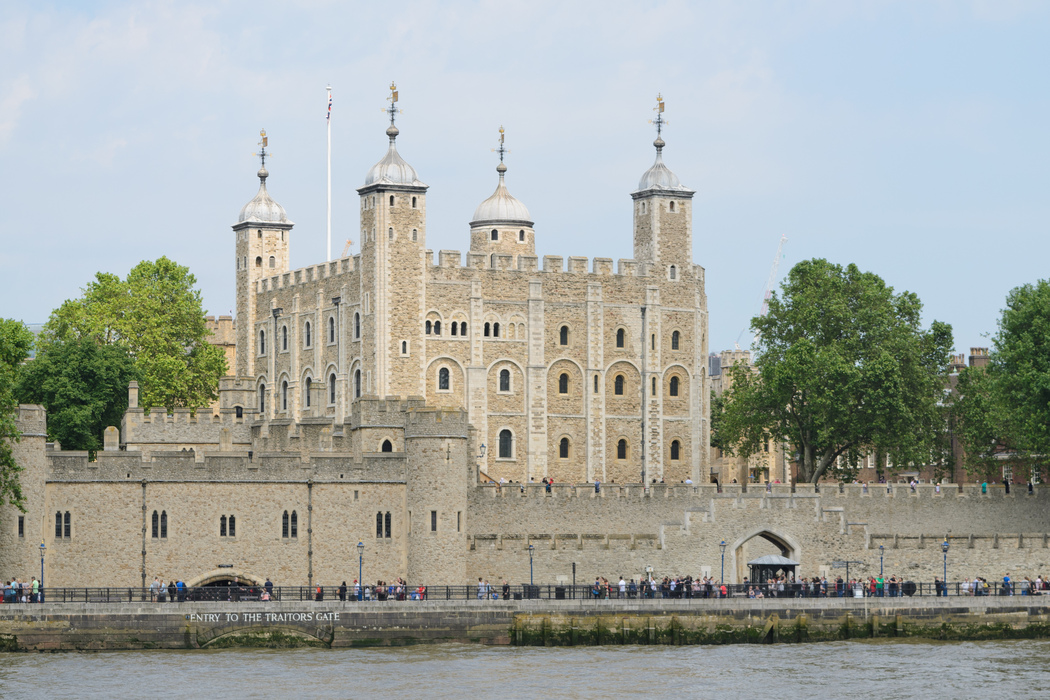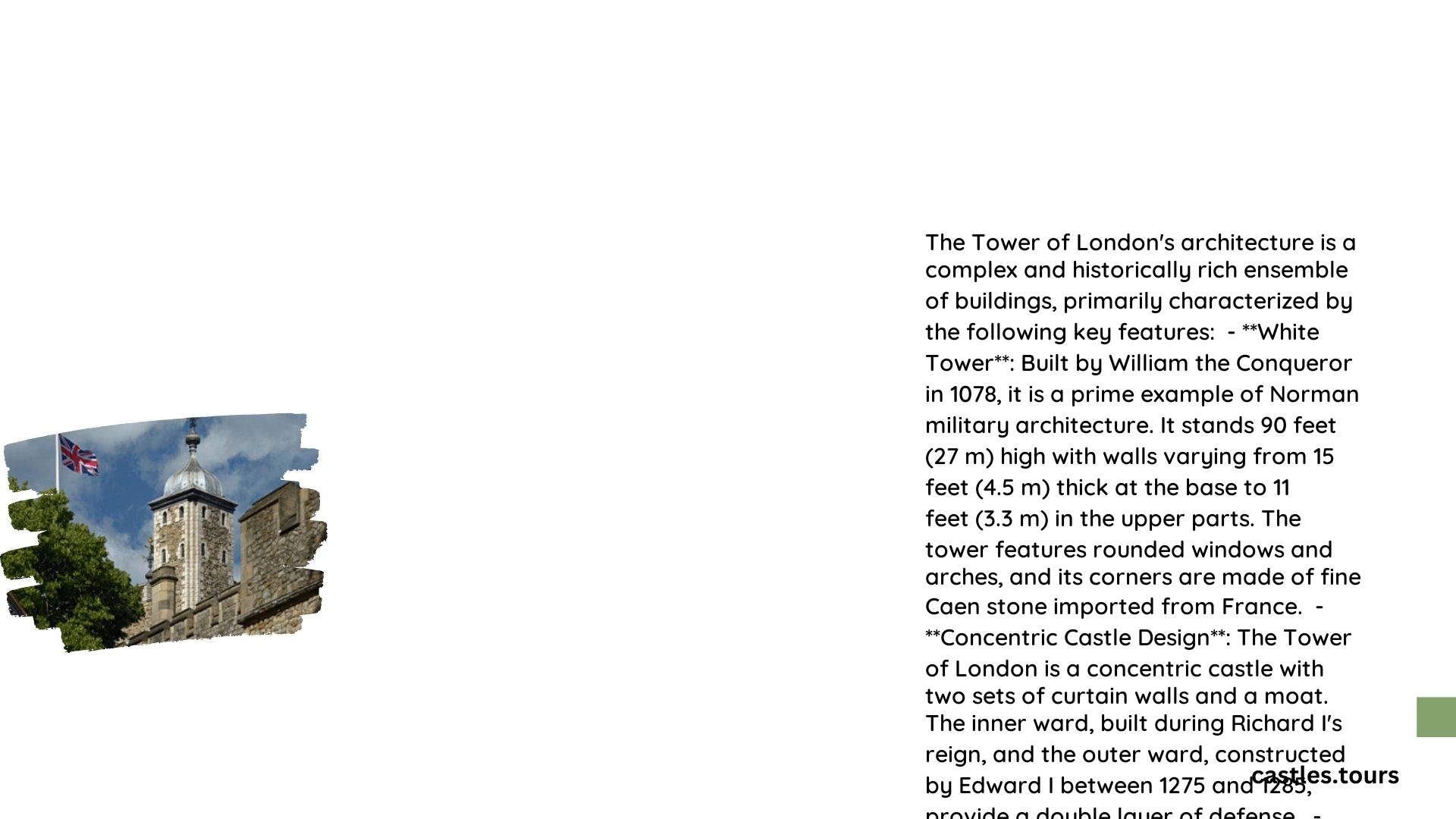The Tower of London, a historic castle and fortress complex on the north bank of the River Thames in central London, stands as a testament to nearly a millennium of architectural evolution. Its design embodies Norman influence, medieval fortification techniques, and centuries of modifications. The complex spans 18 acres, featuring concentric defensive walls, numerous towers, and a central keep known as the White Tower.
What Are the Key Architectural Elements of the Tower of London?

How Does the White Tower Exemplify Norman Architecture?
The White Tower, the oldest part of the complex, is a quintessential example of Norman architecture. Begun around 1078 by William the Conqueror, it showcases:
- Square towers at the western corners
- A round tower housing a spiral staircase at the north-east corner
- A semi-circular projection at the south-east corner for the chapel apse
- Limestone construction from Caen, Normandy
- Thick walls with built-in latrines and fireplaces
The White Tower’s design reflects both defensive and residential purposes, a hallmark of Norman keeps. Its imposing structure served as a symbol of Norman power and influence in England.
What Defensive Features Define the Tower’s Architecture?
The Tower of London’s architecture is characterized by its multi-layered defensive design:
- Inner Ward: Built during Richard I’s reign, it encircles the White Tower and features 13 towers, including:
- Bloody Tower
- Beauchamp Tower
-
Wakefield Tower
-
Outer Ward: Constructed under Edward I, it encompasses the entire castle with:
- A second defensive wall
- Six towers along the river face
-
Two semi-circular bastions at the north-west and north-east corners
-
Moat: Originally fed by the Thames, it provided an additional layer of defense (drained since 1843)
This concentric castle design, with multiple rings of fortification, represents advanced medieval military architecture.
What Construction Materials Were Used in the Tower’s Architecture?
The Tower of London’s construction utilized a variety of materials, each chosen for specific purposes:
| Material | Use |
|---|---|
| Caen Limestone | Primary material for the White Tower |
| Kentish Ragstone | Main building material for other structures |
| Local Mudstone | Used in conjunction with other materials |
| Reigate Stone | Used for ashlar and carved details |
| Portland Stone | Replaced much of the original Caen stone in later restorations |
The use of these materials reflects both the availability of local resources and the importation of high-quality stone for prestigious elements of the structure.
How Has the Tower’s Architecture Evolved Over Time?

What Restorations Have Shaped the Tower’s Current Appearance?
The Tower of London has undergone numerous restorations and modifications throughout its history:
- 17th and 18th Centuries:
- Replacement of original Caen stone with Portland stone
-
Modernization of various structures
-
1990s Restoration:
- Focused on medieval apartments in Wakefield and St. Thomas’s towers
-
Aimed to maintain the original medieval appearance while ensuring structural integrity
-
Ongoing Conservation:
- Regular maintenance and repairs to preserve historic fabric
- Balancing modern visitor needs with historical authenticity
These restorations have sought to preserve the Tower’s medieval character while addressing the wear of time and changing functional requirements.
What Original Design Features Remain in the Tower’s Architecture?
Despite centuries of modifications, several original design features contribute to the Tower’s medieval appearance:
- Concentric Castle Layout: The basic structure of inner and outer wards remains intact
- Defensive Structures: Many towers and curtain walls retain their original form
- Medieval Windows: Two original windows, though restored, remain in the south wall at the gallery level of the White Tower
- Chapel and Residential Chambers: The White Tower still houses these original features, reflecting its dual role as fortress and palace
These elements provide a tangible link to the Tower’s medieval origins and architectural heritage.
What Are the Most Notable Architectural Features of the Tower of London?
The Tower of London boasts several architectural features that define its character and historical significance:
- The White Tower:
- Central keep and oldest part of the complex
-
Symbol of Norman power and architectural skill
-
Traitors’ Gate:
- 13th-century watergate
- Used to bring prisoners into the Tower
-
Iconic symbol of the Tower’s role in English history
-
Bloody Tower:
- Part of the inner ward defenses
-
Associated with numerous historical events and legends
-
Beauchamp Tower:
- Notable for its prisoner graffiti
-
Exemplifies the Tower’s role as a state prison
-
Wakefield Tower:
- Houses the Crown Jewels
- Demonstrates the Tower’s evolution from fortress to treasury
These features not only showcase the Tower’s architectural diversity but also highlight its multifaceted role in English history.
How Does the Tower’s Architecture Reflect Its Historical Functions?
The Tower of London’s architecture reflects its various functions throughout history:
- Royal Residence:
- Luxurious apartments within the White Tower and other buildings
-
Ornate decorations and comfortable living spaces
-
Fortress:
- Thick walls, multiple defensive layers, and strategic positioning
-
Designed to withstand sieges and protect the monarchy
-
Prison:
- Secure chambers and cells within various towers
-
Traitors’ Gate for dramatic prisoner arrivals
-
Armory and Treasury:
- Secure vaults and storage areas
-
Jewel House for the Crown Jewels
-
Tourist Attraction:
- Modern facilities integrated into historic structures
- Preservation of key architectural elements for public viewing
This architectural versatility has allowed the Tower to adapt to changing roles while maintaining its historical significance.
The Tower of London’s architecture stands as a remarkable testament to English history, blending Norman influences, medieval military engineering, and centuries of adaptation. Its complex design, from the iconic White Tower to the intricate defensive systems, continues to captivate visitors and scholars alike, offering insights into the evolution of castle architecture and the changing face of power in England.
